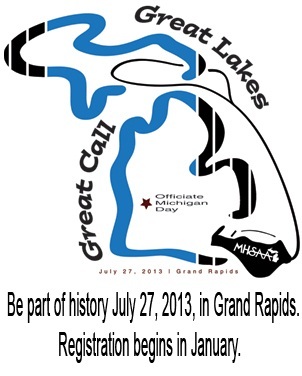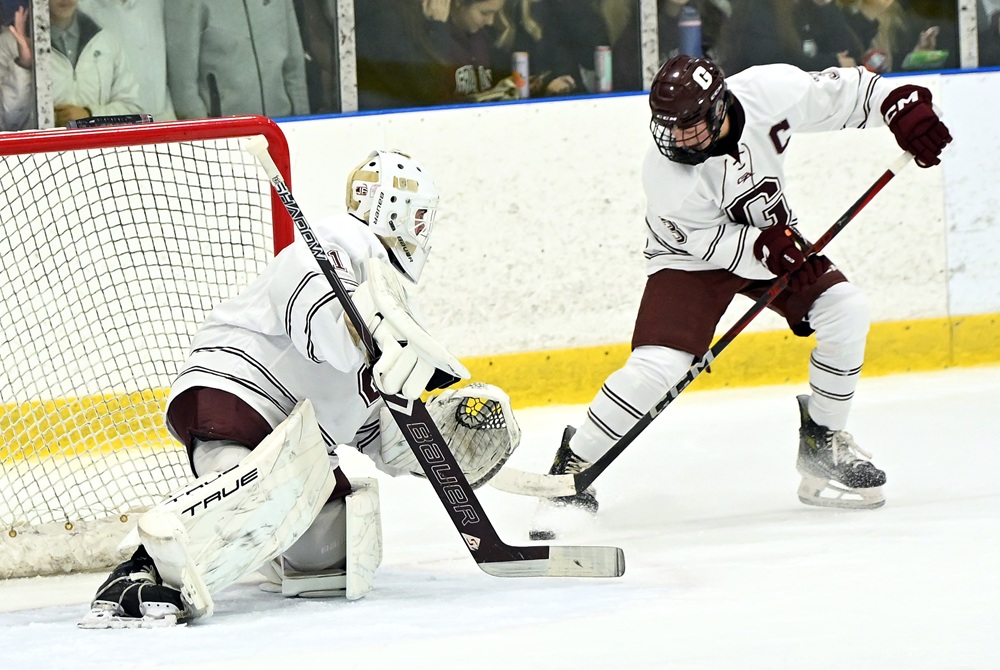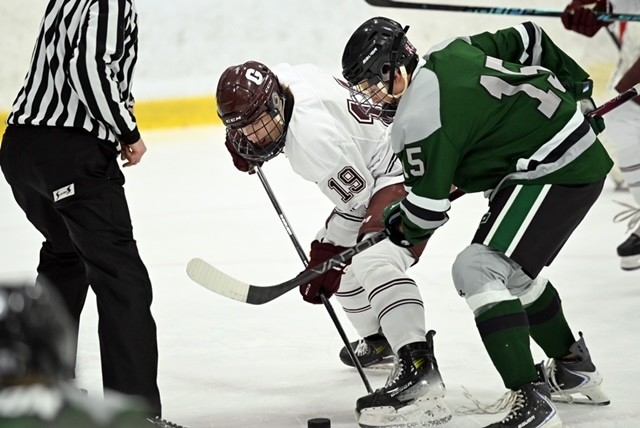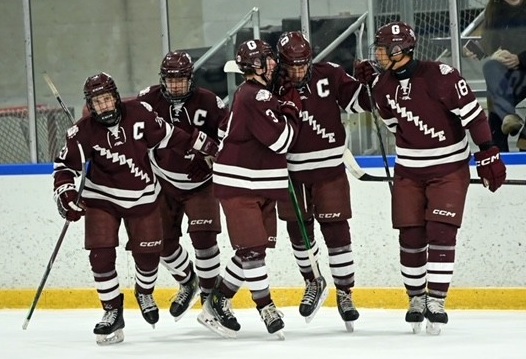
Garofalo: On-Ice Teacher and Recruiter
By
Rob Kaminski
MHSAA benchmarks editor
December 28, 2012
Something caught his eye as Allen Park’s Jim Garofalo circled the Olympic hockey rink in Salt Lake City to familiarize himself with the surroundings prior to the start of play at the 2002 Games.
“When the dimensions of a rink are laid out, everything is measured from the exact center of the ice outward,” Garofalo explains. “Usually there’s a washer or something small under the surface at center ice. All measurements are taken from there.
“Well, in Salt Lake City that year, a Canadian company was hired to prepare the sheets of ice, and they used a Loonie (common term for a Canadian $1 coin) to mark center ice. That year, the Canadians beat the United States in the gold medal game and won the Olympics on U.S. soil. I later visited the Hockey Hall of Fame in Toronto, and that Loonie is there.”
As Garofalo was getting acquainted with Canadian currency, an invitation in his mailbox back home went unanswered. At the time, MHSAA Tournament invitations were still sent by mail, so Garofalo was unaware the Association was awaiting his RSVP to accept his first Finals assignment.
“I was in Salt Lake City and had no idea. Now, of course, everything is online and by email, but that just shows how rapidly technology has progressed in the last 10 years,” Garofalo said. “So, (fellow official) Dan DiCristofaro calls and says something like, ‘Hey, do you want your state final?’ It was pretty funny; the running joke afterward was that you’ve gotta work the Olympics to get a shot at the state finals.”
Of course, that’s not the case. And, if Garofalo had it his way, all hockey officials who worked hard, persevered, paid their dues and set that as a goal would get a shot at the MHSAA Finals.
A 25-year registered MHSAA official who at one time juggled rules books for eight different hockey leagues and has worked four World Championships in addition to the Olympics, Garofalo now works only high school hockey.
“From a selfish standpoint, I suppose, I like a season that has a definite start and end to it,” says the New Boston Middle School social studies teacher, whose resume’ at one point looked like an endless Scrabble hand that included abbreviations for USA, USA Junior, Ontario, East Coast, International, International Independent and Central Collegiate hockey leagues in addition to the MHSAA.
“Being a teacher, there’s so much about the high school game that fits into education,” said Garofalo, now in his 10th year with the New Boston Huron District. “There’s so much to learn, and to help people learn at this level, from a playing and officiating standpoint.
“The people who officiate high school hockey are dedicated to improving, and as a veteran there’s an opportunity to help them learn and advance,” he says. “And, the coaches deserve kudos too. They are usually more professional and ask questions more properly than at other amateur levels. The reason is a direct result of them being accountable. They’ve got to answer to their principal or athletic director. Who are the junior and community league coaches accountable to? No one.”
 And, there’s another allure to the school game compared to which other levels pale.
And, there’s another allure to the school game compared to which other levels pale.
“The atmosphere of high school hockey is better than any other amateur level,” Garofalo says. “You go do a game at Trenton, and there’s a band. How many hockey games do you go to where there’s a band? Detroit Catholic Central and Birmingham Brother Rice have their cheering sections. It’s just a great atmosphere.”
It’s a scene that would surely help maintain the roster of younger, driven hockey officials. The trick is getting them there, according to Garofalo, one of the MHSAA’s biggest proponents for advancement and recruitment of officials.
Part of the issue is the oversaturation of games that fill Mite, Midget and other amateur schedules. Those who simply want a paycheck are never at a loss for work as long as they know how to skate.
“Hockey is unique because high school hockey is in progress at the same time as USA Hockey. An official can get twice the pay at a Bantam/Midget doubleheader than they can for one high school game,” Garofalo said. “The trouble is, who is instructing them? Who’s helping them to develop?”
To that end, Garofalo, DiCristofaro and the rest of the Northeast Hockey Referees Association established a $500 college scholarship. The recipient must be a high school hockey player who is officiating games in USA Hockey. Once they graduate from high school, many join the Association to work high school hockey.
Garofalo also offers other recruiting initiatives. In the Michigan Interscholastic Hockey League most schools play JV/Varsity doubleheaders, where the officials often let a linesman work a game at referee, while the experienced referee observes.
“At events like the Trenton Showcase, if we divide the fees differently we could get more officials involved,” he suggests. “We can do four-person crews to get our good young people some varsity experience as linesmen, and move some of our experienced linesmen to referee on the same crew with some of the top referees.”
It’s the kind of continual teaching that perpetuates the quality of officiating, and it takes time. The goal is to have the officials ready to perform when they hit the ice.
“If I put you out there to referee or pull lines, I set you up to succeed,” Garofalo says. “If I put people in too soon, I’ve set them up to fail, which leads to them leaving the game, and I haven’t done my job.”
The expectations and production of teacher and student must mesh for the system to work as intended. It requires patience as officials strive to climb the ladder, a bit of a lost art in today’s society.
“The culture of newer officials today is different. It’s a culture of immediate gratification,” says Garofalo. “Very few want to hang around eight to 10 years as a linesman before they referee, or move up. There are some very good officials who leave each year, because they haven’t become a referee, or haven’t got a tournament assignment.”
At the MHSAA Finals, Garofalo and DiCristofaro assist Jim Gagleard and the Livonia Ice Hockey Officials in heading up the off-ice officials. The inclusion and experience of such officials serves as a motivational tool which leads to improvement and retention. He also believes a four-person system in the MHSAA tournament would not only afford more qualified officials an opportunity for postseason assignments, but also provide better ice coverage as the sport’s speed has increased dramatically.
Not everyone can reach the summit, no matter the level. Even Garofalo himself, who once entertained dreams of skating in the NHL.
“The NHL looked at me a bit, but when I was at that age, it seemed all of the other linesmen were in their prime,” he said. “It is what it is.”
But, for a guy who began officiating at age 15 just to help pay for his hockey equipment, things have turned out quite well. In addition to the 2002 Olympics, Garofalo worked the Women’s World Championships in 1990, and the Men’s Worlds in Switzerland (1998), Norway (1999) and Germany (2001), working the Gold Medal game in 1998 and 1999. He’s been a fixture at the MHSAA tournament during the last dozen years.
“My wife, Mary Beth, says, ‘Wherever you go, you know someone.’ I owe that to officiating; the places I’ve gone and the people I’ve met,” Garofalo said. “It’s taken me all over the country instructing, and even overseas for some assignments. I can’t help but know people. It’s a people business.”
It might seem odd for Garofalo to even utter those words, describing the people-person this once shy kid has become. That’s one of the many rewards officiating delivers which is more valuable than any top-level assignment or game fee.
“I was quiet when I was younger. Well, when a coach is going crazy and yelling, you’ve got to speak for yourself. You learn conflict resolution,” Garofalo says, continuing as if he wrote the book on it. “‘Coach, get off the bench, quit screaming, and I’ll explain what I saw and why I called it the way I did. Then , if you have a question, I’ll answer it.’ You learn to communicate with people who don’t always agree with you.”
Then, there are the memories. Memories won’t buy a thing, but they go a long way in making 25 years on the ice, thousands of miles on the road, and countless hours away from home worth a million bucks.
“I worked 25 years for the IHL and AHL, and two years ago at the end of the regular season I was doing a Grand Rapids Griffins game. During the game, I told Brad May, ‘I’m done,’” Garofalo recalls, confiding in the gritty enforcer and one-time Stanley Cup champion who had more than 1,000 NHL games under his pads.
“At the end of the game, every guy and coach skated to me and shook my hand. Then Brad May says, ‘I heard you once worked the Olympics. It was an honor to be on the ice with you,’” Garofalo reveals, shaking his head. “Brad May said that to me.”
PHOTO: Jim Garofalo (center) officiate an NHL game. The Allen Park resident also has worked the Olympics.
NOTE: This is the sixth installment in the series "Making – and Answering – the Call" detailing the careers and service of MHSAA officials. Click the links below to view the others.

Grandville Seniors Striving to Finish Time Together with Another Memorable Run
By
Dean Holzwarth
Special for MHSAA.com
December 19, 2025
GRANDVILLE – A talented group of nine seniors on the Grandville hockey team have been playing together since they first learned to skate.
 Now, in their final season on the ice, they have sights fixed on ending their careers with another successful campaign.
Now, in their final season on the ice, they have sights fixed on ending their careers with another successful campaign.
“It's been really nice to play one last time with some of the guys you’ve been playing with since the youth hockey years and then playing together all four years in high school,” senior goalie Ayden Karas said. “ The chemistry and bond we’ve had all together really makes it one big family.”
Grandville senior Braden Vander Veen sees it as one last opportunity to make a lasting impact on the program.
“It’s been awesome to play with all these guys, and we have a ton of chemistry,” Vander Veen said. “We know we only have a certain amount of time left with each other, so we are just trying to leave it all out there.”
The Bulldogs, who lost in last year’s Division 2 Semifinal to eventual champion Flint Powers Catholic, have picked up where they left off en route to a solid 7-1-1 start to this season.
Longtime Bulldogs coach Joel Breazeale, who last month was recognized as the Michigan High School Coaches Association (MHSCA) Coach of the Year, said expectations remained lofty this winter with the return of several experienced players.
“Very happy with how we have played and I think the players would say they are pleased, but I don’t think they are surprised,” he said. “I think that’s the standard they’ve come to expect over the past two seasons, especially with this senior class that have been together with me since they were 4 or 5 years old. This is their opportunity to see it all the way through.”
 Grandville, currently ranked No. 4 in Division 2, dropped its first game to second-ranked Trenton at the West Michigan Showcase, but bounced back the next day to defeat one of the top teams in Division 3.
Grandville, currently ranked No. 4 in Division 2, dropped its first game to second-ranked Trenton at the West Michigan Showcase, but bounced back the next day to defeat one of the top teams in Division 3.
The Bulldogs rallied to knock off Houghton 4-3.
“We’ve had some good and solid close games with them, but we never had an opportunity to play them at a neutral site,” Breazeale said. “For our guys, especially with the returning boys, this was an opportunity that we don’t get too often and they just dug a little deeper.
“I thought we played wonderfully the night before against Trenton but the game got away from us, and I felt like the kids came out in the second period (against Houghton) and just picked up where they left off and their coach said that they just couldn't keep up with our guys. We were remarkably consistent with our energy and our ability to stay on top of the puck, constant pressure.”
It was the first time the seniors had beaten Houghton.
“That was huge,” Vander Veen said. “Obviously the night before we played Trenton, which was our first real test, and then beating Houghton, who is one of the best teams in the state, felt great. It really gave us a lot of confidence.”
Six of Grandville’s wins have been shutouts as an aggressive defense and stout goaltending have been complemented by timely goal scoring from a balanced line-up.
“I feel like the season has been going pretty well, we’ve had some good games the past couple weeks,” Karas said. “The defense has been a really big reason why I've performed so well, and they've always been really helpful in front.
 “Expectations were really high this year, especially coming off a final four run last year, but it's a new team and a new year.”
“Expectations were really high this year, especially coming off a final four run last year, but it's a new team and a new year.”
A promising group of younger players also have blended in well to provide depth.
“We have a ton of experience, and we took in a lot of young guys this year,” Vander Veen said. “It’s huge being able to mentor those guys and carry on with the success that we had last year. We have a lot of guys coming back who are hungry for more.
“We have definitely put in a ton of work in the offseason and with what we did last year, we were expecting to be up there this year. We are working toward that final four run again.”
Breazeale is looking for continued growth from his team as the season progresses.
“Marginal gains is what we’re focused on with the returning players, and then really hoping to see a jump from the new sophomores and juniors on the team,” he said. “The larger gains from our newest members will really determine how competitive we are with our depth because for any team to be successful it’s going to take more than just the leading cast members.”
The Bulldogs host Hudsonville on Friday before another road test Saturday against Rockford.
 Dean Holzwarth has covered primarily high school sports for Grand Rapids-based WOOD-TV for five years after serving at the Grand Rapids Press and MLive for 16 years along with shorter stints at the Ionia Sentinel and WZZM. Contact him at [email protected] with story ideas for Allegan, Kent and Ottawa counties.
Dean Holzwarth has covered primarily high school sports for Grand Rapids-based WOOD-TV for five years after serving at the Grand Rapids Press and MLive for 16 years along with shorter stints at the Ionia Sentinel and WZZM. Contact him at [email protected] with story ideas for Allegan, Kent and Ottawa counties.
PHOTOS (Top) Grandville’s Braden Vander Veen (3) gets his stick on the puck as goalie Ayden Karas walls off that side of the net during a game this season. (Middle) Luke DeBoer (19) takes a faceoff against Jenison. (Below) A group of Bulldogs skate side by side, including Vander Veen and Lewis Gardine (18). (Photos by Jenn Bellgraph Photography.)

